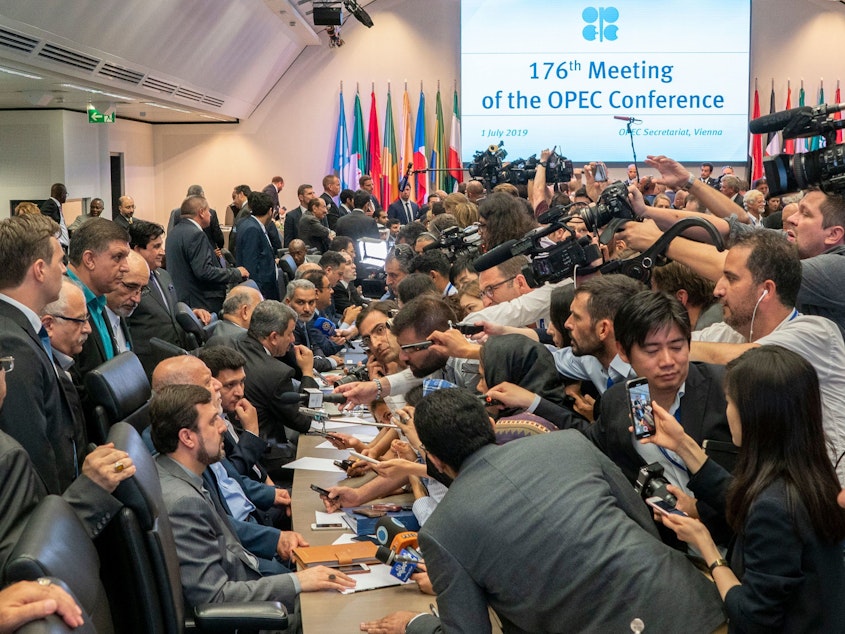OPEC Extends Production Cuts For 9 Months, To Shore Up Oil Prices

OPEC and other, allied major oil producers have agreed to extend crude oil production cuts for another nine months, in a move designed to keep oil prices from falling as U.S. production increases and concerns grow about global demand.
Crude oil prices rose after early reports of OPEC's decision. However, prices are not expected to rise dramatically, as countries that don't cooperate with OPEC— — like the United States — have enough capacity to meet projected growth in demand.
OPEC's supply cuts, which Russia and several other non-member countries are also observing, were put in place on a temporary basis at the beginning of 2017. They are credited with helping stop a dramatic multi-year slide in oil prices, and OPEC has opted to extend the cuts repeatedly since then.
Ahead of Monday's meeting, the organization had been widely expected to extend cuts by at least six months.
The deal technically needs to be approved by participating non-OPEC members in a meeting on Tuesday.
But Russia, by far the most significant non-OPEC partner, has already indicated it is willing to cooperate with production cuts.
Shifting geopolitics
Some of OPEC's production cuts are outside of the cartel's control.
Iran, a founding member of OPEC, is under pressure from U.S. sanctions after President Trump withdrew from the Iran nuclear deal. As a result, Iran has struggled to export its crude oil.
Venezuela, another OPEC member, has also been hit by U.S. oil sanctions, further contributing to reductions in OPEC production.
More broadly, the agreement to keep cuts in place comes during a period of intense geopolitical tension.
Iran continues to object strongly to the influence of regional rival Saudi Arabia over OPEC decisions, particularly as an alliance between Saudi Arabia and Russia holds growing sway over the cartel.
Since these production cuts were agreed upon in late 2016, non-OPEC members like Russia have bolstered the organization's ability to influence the global oil market. While OPEC controls less than 50 percent of the world's crude oil production, the expanded coalition, known as "OPEC+," controls a majority.
Russia, despite not being an OPEC member, accordingly holds significant sway over OPEC decisions. In fact, Monday's meeting, originally planned for late June, was rescheduled at Russia's request — creating some controversy within OPEC's actual membership.
Meanwhile, the United States — emphatically not a member of OPEC — has been increasing oil production at a rapid clip. The boom in the Permian Basin has made the U.S. the world's top oil producer.
When OPEC countries cut their production, it boosts the fortunes of members and non-member partners alike. But it also leaves a larger slice of the market available to others. So when OPEC+ limits production it benefits American producers, albeit unintentionally, helping the U.S. claim a growing share of the global oil market.
Eying future demand
Concerns over growing U.S. production are not the only spur for the OPEC+ production cuts. The cartel and its allies are also worried about softening demand growth.
Just last month, OPEC announced it was lowering its expectations for future world oil demand.
The International Energy Agency, or IEA, also projects softening demand growth. The IEA says there are multiple factors, including "a warm winter in Japan, a slowdown in the petrochemicals industry in Europe, and tepid gasoline and diesel demand in the United States."
But one factor looms large across the world, the IEA says: Concerns over the future of global trade.
Economists expect the global economy to slow down over coming months and years. And the tensions between the U.S. and China — among other trade wars — have heightened concerns about an economic cooldown.
Meanwhile, in the long-term, changes in transportation — particularly the rise of electric vehicles — and government policies designed to reduce the severity of global climate change could put put downward pressure on oil demand.
However, analysts believe demand for oil has not peaked. While demand growth may be slowing down, the global appetite for oil is continuing to increase — just at a slower rate than OPEC and the IEA had previously anticipated. [Copyright 2019 NPR]



